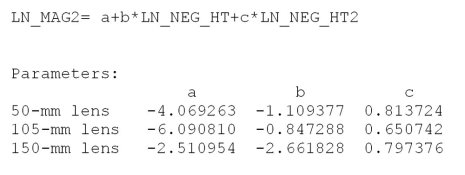dkonigs
Subscriber
I recently started working on an Android app that serves as a printing adjustment calculator. Specifically, it allows you to quickly and easily determine the difference in print exposure times when changing the height of your enlarger.


Its capable of working in two modes: calibrated and uncalibrated.
In uncalibrated mode, it simply uses the following formula which I've seen posted around these parts before:
new_time = old_time * (new_magnification + 1)2 / (old_magnification + 1)2
In calibrated model, you give it the height (negative-to-print distance) of your enlarger and exposure time for two matching test exposures at the extremes of your usual printing size range. It then uses the above formula (from both ends) to estimate a midpoint exposure and interpolate the height-to-exposure-time curve for your specific enlarger. It then uses that curve to calculate the new exposure when you change the height of your enlarger. (Those test exposures can be made via actual darkroom work, or via a good enlarger meter. As I have an RH Analyser Pro, I obviously prefer the latter.)
The signup link for the beta version is here:
https://play.google.com/apps/testing/org.logicprobe.printsizer
And the store page is here:
https://play.google.com/store/apps/details?id=org.logicprobe.printsizer
Since this app is entirely open-source as well, the code and some basic descriptions of how it works can be found here:
https://github.com/dkonigsberg/printsizer
(This is actually my first Android app, so I'm hoping it'll motivate me to keep adding more features and perhaps develop other apps in the future as well.)
The inspiration for this project came out of seeing a certain heavily promoted iPhone app, and wondering how it actually worked. (I'm not an iPhone user, nor do I intend to become one.) Despite that app having extensive documentation and promotion on why its useful and what it does, there was almost nothing on how its math actually worked. So I took a whole bunch of measurements with my darkroom equipment, spent a lot of time looking up various formulas, and think I managed to figure it out. Or at least I figured out an approach that seems to get similar results. As I only have one enlarger, there's obviously a limit to how much experimental testing I can really do.
I'd love to make it possible to use a smartphone's ambient light sensor to calibrate the app, but unfortunately its measurements are not repeatable enough (and perhaps also not accurate enough) to be useful at the light levels typical for printing. Its possible it might work better if I opened up the lens aperture all the way, but my enlarger is brighter than average.
In the future, I'd like to also add the ability to convert exposures between different paper stocks. From my reading of paper datasheets and the actual definition of paper ISO(P)/ISO(R), that absolutely seems do-able.


Its capable of working in two modes: calibrated and uncalibrated.
In uncalibrated mode, it simply uses the following formula which I've seen posted around these parts before:
new_time = old_time * (new_magnification + 1)2 / (old_magnification + 1)2
In calibrated model, you give it the height (negative-to-print distance) of your enlarger and exposure time for two matching test exposures at the extremes of your usual printing size range. It then uses the above formula (from both ends) to estimate a midpoint exposure and interpolate the height-to-exposure-time curve for your specific enlarger. It then uses that curve to calculate the new exposure when you change the height of your enlarger. (Those test exposures can be made via actual darkroom work, or via a good enlarger meter. As I have an RH Analyser Pro, I obviously prefer the latter.)
The signup link for the beta version is here:
https://play.google.com/apps/testing/org.logicprobe.printsizer
And the store page is here:
https://play.google.com/store/apps/details?id=org.logicprobe.printsizer
Since this app is entirely open-source as well, the code and some basic descriptions of how it works can be found here:
https://github.com/dkonigsberg/printsizer
(This is actually my first Android app, so I'm hoping it'll motivate me to keep adding more features and perhaps develop other apps in the future as well.)
The inspiration for this project came out of seeing a certain heavily promoted iPhone app, and wondering how it actually worked. (I'm not an iPhone user, nor do I intend to become one.) Despite that app having extensive documentation and promotion on why its useful and what it does, there was almost nothing on how its math actually worked. So I took a whole bunch of measurements with my darkroom equipment, spent a lot of time looking up various formulas, and think I managed to figure it out. Or at least I figured out an approach that seems to get similar results. As I only have one enlarger, there's obviously a limit to how much experimental testing I can really do.
I'd love to make it possible to use a smartphone's ambient light sensor to calibrate the app, but unfortunately its measurements are not repeatable enough (and perhaps also not accurate enough) to be useful at the light levels typical for printing. Its possible it might work better if I opened up the lens aperture all the way, but my enlarger is brighter than average.
In the future, I'd like to also add the ability to convert exposures between different paper stocks. From my reading of paper datasheets and the actual definition of paper ISO(P)/ISO(R), that absolutely seems do-able.

















